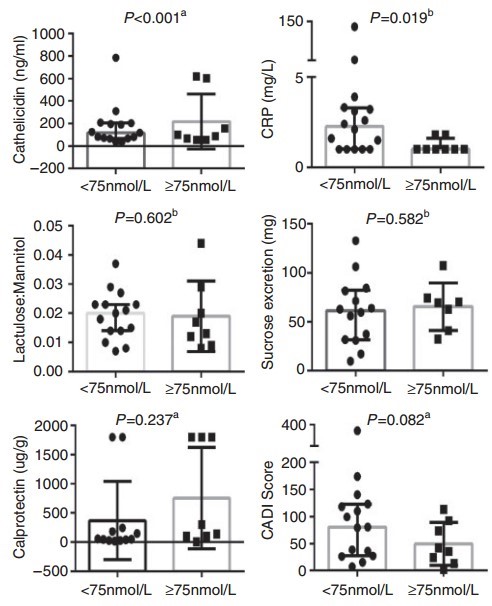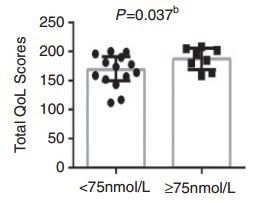Crohn’s disease helped when vitamin D level raised above 30 ng – RCT
Effects of vitamin D supplementation on intestinal permeability, cathelicidin and disease markers in Crohn’s disease: Results from a randomised double-blind placebo-controlled study
United European Gastroenterology Journal February 11, 2015 2050640615572176
Tara Raftery 1, Adrian R Martineau 2, Claire L Greiller 2, Subrata Ghosh 3, Deirdre McNamara 4, Kathleen Bennett 5, Jon Meddings 3, Maria O’Sullivan 1
1 Department of Clinical Medicine, Trinity Centre for Health Sciences, St. James’s Hospital, Dublin, Ireland
2 Blizard Institute, Barts and The London School of Medicine and Dentistry, Queen Mary University of London, London, UK
3 Department of Medicine, University of Calgary, Calgary, AB, Canada
4 Department of Clinical Medicine, Trinity Centre for Health Sciences, Tallaght Hospital, Dublin, Ireland
5 Department of Pharmacology and Therapeutics, Trinity Centre for Health Sciences, St. James’s Hospital, Dublin, Ireland
Maria O’Sullivan, Department of Clinical Medicine, Trinity Centre for Health Sciences, St. James’s Hospital, Dublin 8, Ireland.maria.osullivan@tcd.ie


Background Vitamin D (vitD) supplementation may prolong remission in Crohn’s disease (CD); however, the clinical efficacy and mechanisms are unclear.
Aim To determine changes in intestinal permeability (IP), antimicrobial peptide (AMP) concentrations and disease markers in CD, in response to vitD supplementation.
Methods In a double-blind randomised placebo-controlled study, we assigned 27 CD patients in remission to 2000 IU/day vitD or placebo for 3 mos. We determined IP, plasma cathelicidin (LL-37 in ng/mL), human-beta-defensin-2 (hBD2 in pg/mL), disease activity (Crohn’s Disease Activity Index (CDAI)), C-reactive protein (CRP in mg/L), fecal calprotectin (µg/g), Quality of Life (QoL) and serum 25-hydroxyvitamin D (25(OH)D in nmol/L) at 0 and 3 mos.
Results At 3 mos., 25(OH)D concentrations were significantly higher in those whom were treated (p < 0.001). Intra-group analysis showed increased LL-37 concentrations (p = 0.050) and maintenance of IP measures in the treated group. In contrast, in the placebo group, the small bowel (p = 0.018) and gastro-duodenal permeability (p = 0.030) increased from baseline.
At 3 mos., patients with 25(OH)D ≥ 75 nmol/L had significantly
lower CRP (p = 0.019),
higher QoL (p = 0.037),
higher LL-37 concentrations (p < 0.001)
and non-significantly lower CDAI scores (p = 0.082), compared to those with levels <75 nmol/L.
Conclusion Short-term treatment with 2000 IU/day vitD significantly increased 25(OH)D levels in CD patients in remission and it was associated with increased LL-37 concentrations and maintenance of IP. Achieving 25(OH)D ≥ 75 nmol/l was accompanied by higher circulating LL-37, higher QoL scores and reduced CRP. Registered at ClinicalTrials.gov (NCT01792388).
